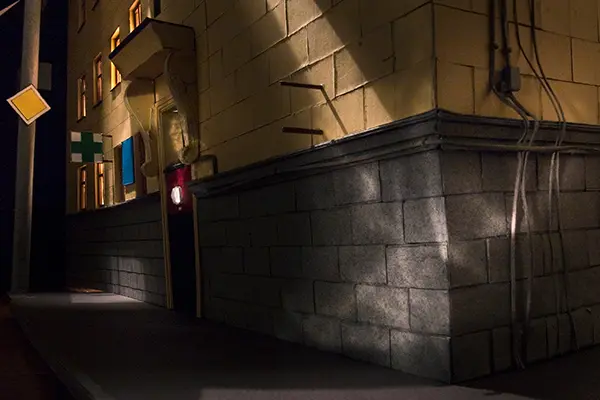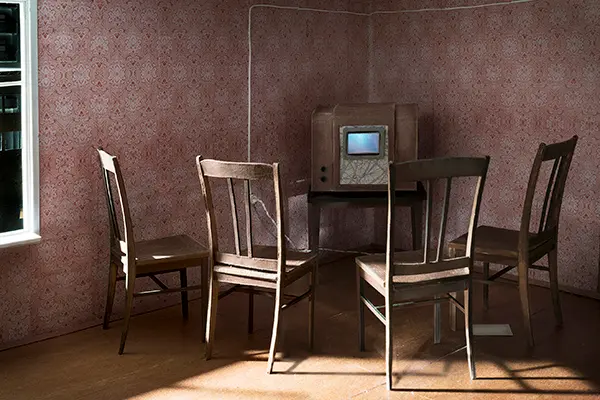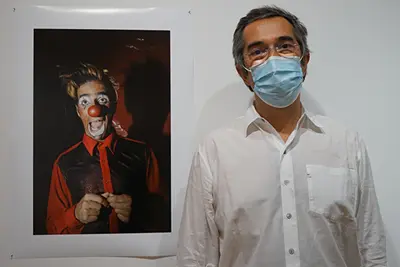Art Professor’s Walls, Empty Spaces Speak Quiet Volumes About Historical Memory
 Image by Pavel Romaniko
Image by Pavel Romaniko
03/21/2022
By Katharine Webster
Asst. Teaching Prof. Pavel Romaniko, whose family has roots in both Ukraine and Russia, is divided by war.
Yet long before Russia invaded Ukraine, Romaniko, of the Department of Art and Design, was meditating on the diminishment of free artistic and political expression and the erasure of historical memory in Russia through his photographs of reconstructed, depopulated spaces.
His book, exhibit and ongoing photographic project “Nostalgia: A Guide to Collective Melancholie” brings to mind the saying, “If these walls could talk.”
 Image by Pavel Romaniko
Image by Pavel Romaniko
Romaniko, who directs the new digital media major, first came to the United States from Russia as a high school exchange student and later earned his B.A. at Northwestern College, a small Baptist school in St. Paul, Minnesota. He earned his M.F.A. in imaging arts at Rochester Institute of Technology and has taught at UMass Lowell since fall 2015.
Recently, he spoke about his work and the war.
Q: All of the works in “Nostalgia” are photos of intricate paper models. Why make these detailed models in paper when you could create images digitally?
A: In “A Guide to Collective Melancholie,” I restore things. I either go to a physical space or I find a photograph – mine or someone else’s, significant or insignificant – and then I reconstruct it as a miniature paper model, light it and re-photograph it.
 Image by Pavel Romaniko
Image by Pavel Romaniko
In the Soviet Union, they would say, “If you don’t have a document, you don’t exist.” My birth certificate is a piece of paper that has no actual relationship to fact, yet it’s so important.
I was born in Kazakhstan when it was part of the USSR, but when I was 1 month old, my family moved to a small town outside Moscow where my dad’s parents lived. When my grandfather died shortly afterward, my parents wanted to rename me after him – and to get a new birth certificate with a new name on it, they had to list me as being born there.
Q: Why is your work titled “Nostalgia”?
A: The title is satire. Nostalgia is dangerous because it requires no imagination.
Nostalgic thinking never implies an actual place; it implies a return to a utopian space. It employs a sense of historical forgetting, and in the present moment, it manufactures a context for that past that’s utopian or idealistic – and then seeks to project that into the future.
 Image by Pavel Romaniko
Image by Pavel Romaniko
My art is a reflection on my own futility and impotence in knowing or understanding certain things, but not being able to do anything about them. Protesting in Russia is a deadly sport. There are all these brave people who have resisted knowingly and courageously, and I’m not one of them, so there’s always that sense of helplessness.
Q: The only people present in your “Nostalgia” photos are portraits and sculptures of Soviet and Russian leaders, from Vladimir Lenin to Vladimir Putin. What is the historical context for some of your works?
A: The book begins and ends with photos that show a car, modeled on the Soviet Lada, that has been in an accident. Russian history is an accident that keeps repeating itself. Russians haven’t dealt with their past; they haven’t explicitly acknowledged that what Stalin did in Ukraine was wrong, fundamentally wrong, against his own people. And now they’re trying to bring Stalin back as a hero of the past.
“Untitled (Lesnaya Street)” and “Untitled (Stairwell)” are recreations of the building and hallway where independent journalist Anna Politkovskaya was assassinated on Vladimir Putin’s birthday in 2006.
 Image by Pavel Romaniko
Image by Pavel Romaniko
“Untitled (0.10)” is a reconstruction of the gallery where the artist Kazimir Malevich exhibited his famous painting “Black Square” in 1915, as part of “The Last Futurist Exhibition of Painting 0.10.”
Q: In your reconstruction, the gallery is empty, with only a single canvas turned to the wall. And your photo “Untitled (Gallery)” contains not art, but the standard propaganda photos of Soviet and Russian leaders – minus Mikhail Gorbachev and Boris Yeltsin, who oversaw the dissolution of the Soviet Union and an era of greater political and artistic openness. In your view, what is the relationship between politics and art?
A: Art is never apolitical. The act of making artwork in a totalitarian society is an act of dissent. Simply producing artwork is a form of free expression: It’s why literature is a danger to totalitarian societies, because it undermines their message.
 Image by Pavel Romaniko
Image by Pavel Romaniko
Russia just passed a law killing internal dissent. That’s the context of my work.
Q: You have spoken out about your opposition to the invasion of Ukraine. How has it affected you?
A: Until the minute of the invasion, I and many Russians I know thought the military buildup was a bluff. I just broke down and I wept. I have a lot of friends I would see cry on the phone; they would never support the invasion, but we feel guilt even though we don’t live in Russia and there’s nothing we can do. It’s a feeling of impotence.
It’s hard to find a Russian who doesn’t have connections to Ukraine one way or another, and that’s what makes it almost impossible to grasp. On my mother’s side of the family, my great-grandparents were forcibly resettled from Ukraine to the plains of Kazakhstan under Stalin. My cousin, who I’m very close with, lived in Ukraine most of her life, but she just moved to Russia a few years ago. My uncle lived there for a good part of his life.
The invasion really is just a war of one man, but unfortunately, everyone else is complicit by affiliation. I think that’s what a lot of Russians are feeling now: There’s a lot of shame, a lot of guilt, because they’re feeling complicit.
I love my country, but I don’t love my nation.




